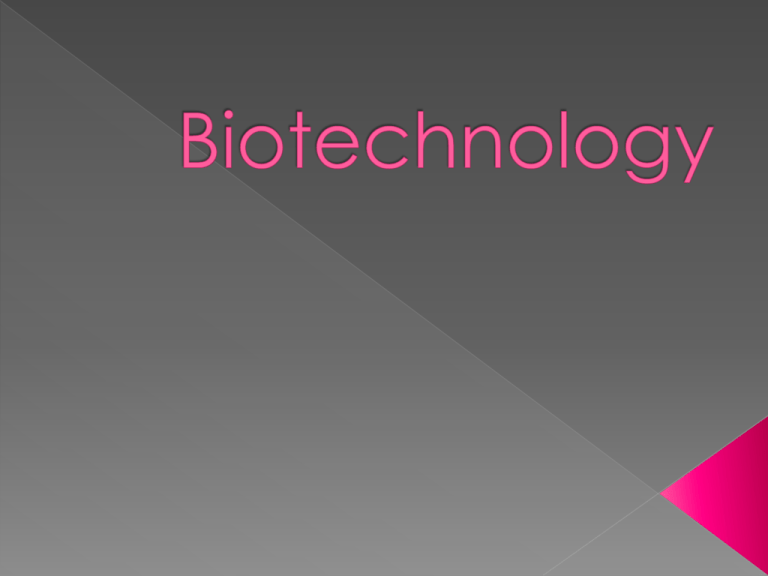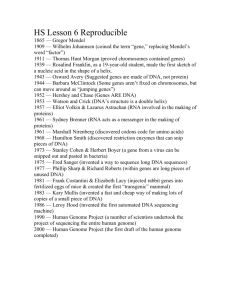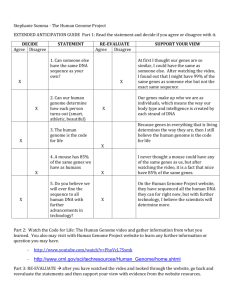Biotechnology - Exploring Science with Mrs. Kievit
advertisement

Any technology based on a biological system or organism Uses organisms to solve real world problems › Used to domesticate animals and plants › Creates safer food sources More recently: › Alter genes of organisms › Clean up wastes › Generate cheaper foods › Create fuel sources Also used in forensics, medicine, agriculture and food processing Bioengineers › Apply engineering principles to living systems. › Create products that meet human needs. Sciences included › Microbiology › Computer › › › › › Explore Careers Technology Robotics Molecular Biology Biochemistry Pharmacology Immunology Forensic Science › Branch of study associated with the legal system › Uses physical evidence Fingerprints Bullet casings Blood splatter › Uses biotechnology Blood typing DNA analysis You are NOT the father! › Scientists use blood type information to establish a child's biological parent. › Humans have four blood types: A, AB, B, and O › Different blood types can not match up together such as a child with blood type O can not have a mother with blood type AB DNA Analysis takes a specific portion of a persons DNA and uses laboratory techniques to examine it more closely This is a more accurate way to prove who a parent is. Once the DNA of a child is mapped, they compare it to the suspected parent to find similarities. This is also used in criminal cases to locate suspects. DNA analysis cannot be used to find a criminal, there must be a sample to compare to the collected DNA. The medical industry has many uses › Genetic testing › Gene therapy › Cloning › Tissue culturing › Development of better drugs Genetic Testing Takes a DNA sample and breaks it apart Human Genome Project › Mapping the human genome Used to screen for diseases › Breast Cancer is an example Gene Therapy Utilizes viruses or bacteria to enter a cell and replace defective genes Believed to be the best way to cure diseases once they have been identified Cloning Creation of genetically identical organisms Many organisms have be cloned “Dolly the sheep” is the most famous Examples of cloning Tissue Culturing Allows bioengineers to grow human tissues and organs in the laboratory Human ears, livers and heart cells have been grown Hoped to be used in organ transplants Drug Development process of bringing a new drug to the market once a lead compound has been identified. One example is bioengineered bacteria used to treat diabetes › Gene used to produce insulin is inserted into bacteria cells. › The bacteria reproduces quickly producing large amounts of insulin Also used to create cheaper antibiotics Genomics › Used to study how the body works › Used to understand how each body is unique Personalized Medicine The study of an organism’s entire genome, including DNA sequencing The use of a patient’s genome to select treatment that is suited to a patient’s individual genes The goal is to develop medicine unique to an individual. Microbiology Field of science that studies microbes › Microbes can work for and against humans Bacteria in our intestines absorb vitamins and minerals Bacteria in soil help plants trap nitrogen for growth Microbes are natures garbage men › Process waste › Recycle matter Bioremediation Uses microbes to remove harmful toxins from the environment Gulf Coast Oil Spill Bioremediation Explaination Used in sewage treatment plants › Harmful chemicals have been used in the past › These have been replaced with microbes They do the job faster Cheaper Do not leave behind harmful pollutants Now being used in household cleaners Breakdown in sunlight Sewage treatment plant, microbes are cleaning the waste Oldest form of biotechnology › Uses artificial (not natural) selection › Increasing yields › Decreases crop stress › Produces food quality Also used with animals › Produces more milk, meat, or wool › Does so quicker than ever before Transgenic Crops Organisms that have genes from a different species artificially inserted into their genome. Plants can be altered to grow more quickly, flower earlier, produce more flowers, and even grow more fruit Insecticides › Chemicals that kill insects Insect Resistant Crops › Crops modified to produce their own insecticides Bt Corn › Specific example of insect resistant crop › Bacillus thuringiensis Bt Corn Video Scientists have noticed that weeds grow in harsh conditions and environments The genes are inserted into transgenic crops › Tomatoes, corn, wheat, rice, or barley This allows domestic crops to grow in harsh conditions and even survive droughts This is an important goal of biotechnology Scientists can control › › › › › Size Taste Amount of nutrients When it ripens How long it stays fresh All this helps control costs and allows people to become healthier while reducing disease. Golden Rice › An example of a crop that has been genetically modified to improve its quality › Makes beta-carotene in its grains Beta-carotene is needed to make vitamin A › Developed to stop malnutrition in Africa and Southeast Asia Children in these areas regularly ate food with too little vitamin A Too little vitamin A can cause disease, illness, blindness, and even death Fear of impact of modified crops › Unforeseen consequences Cross pollinate with wild plants › Harm to people with food allergies › Body reactions to new crops/foods Can they cause diseases? Ethical questions › Is it a good idea? › Human Genome project Who owns the information? Who gets to decide what is a good/bad use? Can we alter the gene to produce specific results? Design your own baby? › Ethical Issues Video Research Triangle › Raleigh/Durham/Chapel Hill Cutting edge research at local Universities attracts many companies that perform tech research and biotech research. Creates jobs in North Carolina Largest research park in the United States Decreasing weeds B. Decreasing pests C. Increasing the growth rate of the crop plant D. Decreasing the number of crop plants A. Improved digestion B. More digestive problems C. Decreased vitamin A absorption D. Increased disease resistance A. A. B. C. D. They do not grow as large or produce as much They can cross pollinate with wild plants They can cause allergies in humans They can cause unknown diseases in humans A. B. C. D. Biochemistry Microbiology Social Studies Pharmacology A. B. C. D. Grow rice in salty soil Grow rice under drought conditions Create better looking rice Create rice that contains more nutrients








